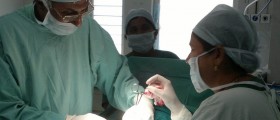
Hernia is usually defined as a protrusion of an organ or a layer of fibrous tissue (fascia) through the wall of the cavity that normally holds it. Typically, hernias develop in the abdomen, when the abdominal wall is so weak at a certain spot, that a localized hole starts to form. Adipose tissue can sometimes protrude through this hole and form a visible or palpable lump. This type of hernia is known as hiatal hernia, and it occurs when the upper part of the stomach protrudes into the thorax through a tear or weakness in the diaphragm. Another very frequent type of hernia is a spinal disc hernia, which causes sciatica (pain that occurs because of the compression of a nerve).
Causes of hernia
The exact cause of hernia depends on each case. In many cases, haital hernia is caused by various medical causes such as an improper heavy physical exercise (such as heavy weight lifting), hard coughing, incorrect posture, wearing of tight clothing or sharp blows to the abdomen. Obese people are also very prone to hernias but many other medical conditions and diseases can also affect these changes in the abdominal wall. For example, any kind of excessive straining during bowel movements is considered risky. People with chronic lung disease, or those with fluid in the abdominal cavity, can develop a hernia eventually. People with very weak muscles are also at risk, especially if they suffer from malnutrition, or if they are smokers. In general, any type of excessive pressure in the abdominal cavity may contribute to the formation of hernia or to worsening of the present one.
Signs and symptoms of hernia
Manifestations of hernia usually vary depending on the exact type of hernia. In most cases, patients are able to feel or see a bulge somewhere in the abdominal region, or around the groin area. The bulge is typically easier to spot when a patient is standing. Sometimes, the patients complain about pain, heaviness or swelling in the scrotum around the testicles area. Two main types of hernia are reducible hernia and irreducible hernia. Reducible hernia appears as a new limp that may occasionally ache, but it is not tender when touched. Sometimes, the feeling of pain may precede the discovery of a lump. Their main characteristic is their ability to become reduced by pushing them back into the abdomen.
On the contrary, irreducible hernia cannot be returned into the cavity, and it is usually painful and enlarged. This type of hernia leads to cutting of the blood supply to tissue in the hernia. As a result, patients may start feeling symptoms of bowel obstruction, nausea and vomiting. This cut-off of blood supply is known as strangulation. Strangulated hernia is characterized by constant pain, tenderness and even fever. This is considered a medical complication and requires surgical emergency.

















Your thoughts on this
Loading...